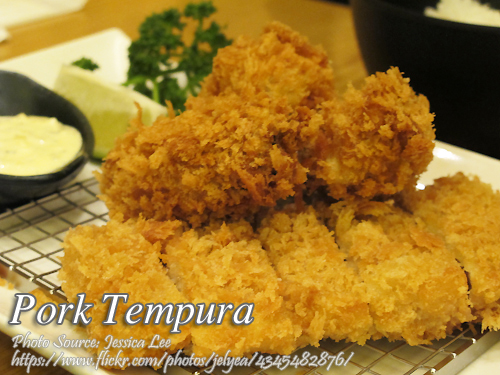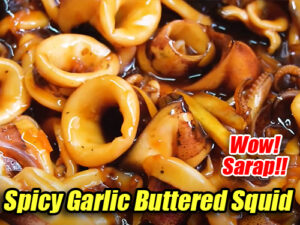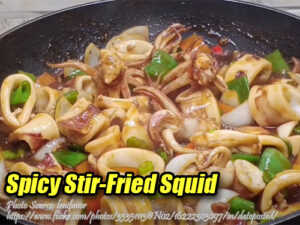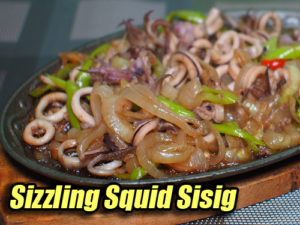Tempura is a well known Japanese dish made usually with shrimps or other seafoods like squid or fish and also vegetables. There are also other version of this tempura using chicken or pork. This time we are using pork as the main ingredient in making pork tempura. The pork part that are used should be tender and ideally you should use pork tenderloin but you can also use other part like the pork shoulder because it is usually available in the market.
The process is also simple and we are not using the batter for coating the pork but some sort of a breading which is a combination of flour, bread crumbs and egg. Sorry folks if this recipe is confusing because making tempura should be coated with batter and not breading like this one. This is closely related to pork tonkatsu. But since it is simpler to cook it this way so I decided to post this recipe here. Anyway this recipe also includes tempura sauce which I’m sure you are going to love.
A Nostalgic Twist on Pork Tempura
I really do believe that tempura is a special dish for many reasons aside from the fact that it has a really good, delicate crunch to its skin. To me, it always brings memories of family gatherings as I grew up. As a common Japanese dish, it often contains seafood like shrimp, squid, or even fish, and vegetables. But for our family, we have always been and are in a love affair with making a version that is slightly changed by pork, a twist that binds together familiar flavors of Japan with the rich, tender texture of pork.
It was at a family reunion in Quezon that I first came across this pork version-it was cooked up by my uncle Lito, who headed the kitchen. He was such a food experimenter, and it came as a shock to everyone when he dished out what would appear to be pork tonkatsu and called it his version of tempura. He said that although most people would identify this as the light, batter-coated seafood often seen in tempura, he preferred the breading made from flour, egg, and bread crumbs. I remember laughing when he said it was closer to tonkatsu but, if changed a little, became tempura in its own right.
This recipe now never fails to find its way into our gatherings. Every time I am making it now, memories of long afternoons cooking with relatives, sharing stories, and enjoying a meal that is very simple to make but very satisfying return.
The Right Cut for the Perfect Tempura
Of course, the entire concept of this pork dish relies in selecting the proper part of the pork. My uncle Lito always said pork tenderloin is the best because of its natural tenderness makes it staple in any dish. It cooks very fast and remains soft, not dry, after frying. To be very honest here, however, not everyone has tenderloin at his discretion. Hence, he also advised using pork shoulder, which is more accessible in the local markets.
This dish is beautiful in its versatility; the shoulder piece has a toughness to it, giving it a deeper, richer flavor when associated with the crunch of the batter. If marinated properly using salt and pepper before cooking, the pork develops a really savory taste, complemented well by the flavor of the tangy and sweet tempura dipping sauce.
One time, my cousin Mariel came home from her trip to Japan bursting with excitement to share her experience on traditional tempura. Upon trying this pork version, she said it was fun and a Filipino twist for the Japanese classic and that the sauce reminded her of the dipping sauces she had savored abroad.
How to Make It Crispy
I have to confess, it does not follow the old-timely way of preparing tempura. The batter has to be no more than a tiny faint mixture out of cold water and flour. In our version, we used breading-a mixture of flour, cornstarch, and breadcrumbs that can turn crispy and golden when fried. It is easier and, in my opinion, much less finicky for beginners.
My uncle taught me this method for the first time. Every time I make it, memories of that incident come rushing into my mind. He said that dredging the pork first in flour and cornstarch helps to stick bread crumbs to the meat better and produces a crispy, crunchy exterior; on the inside, the juice must always be preserved. The eggs, acting as a binder, lock in moisture; you make sure that each bite is moist and flavorful.
The second key lies in the frying. You want to heat the oil right, not too much so the outside goes a bit burnt and inside is still uncooked. Uncle Lito always had this trick of testing the oil by dropping a few bread crumbs on the pan. If they sizzled and floated up immediately, he knew it was the perfect time to start frying.
The Ultimate Dipping Sauce
The whole tempura meal would never be the same without the dipping sauce, so here is one, just like my family uses, easy to make but full of flavor. You combine soy, mirin, and a little sugar to reduce those wonderful flavors into a nicely savory slightly sweet sauce that complements perfectly the fried pork, the savory saltiness balancing breading richness.
This sauce is so easy to prepare, and yet, you can have it ready in only a few minutes – which makes for the perfect accompaniment to busy weeknight meals, times when you want something special but do not want to be slaving away in the kitchen all night. And trust me, this sauce certainly does just that: elevate every fried dish, not just tempura. I even caught my younger brother, a new fan of cooking, dipping his homemade lumpia into it.
A Dish with History
This pork dish may not be strictly a traditional version of tempura, but its pedigree goes back to Japanese cuisine in the Philippines. It is said that tempura itself was introduced into Japan during the 16th century when Portuguese missionaries brought it over. It was in fact created as a fast snack, deep-fried during religious fasting periods where only seafood and vegetables were permitted. Over time, the dish changed; different regions in Japan and beyond adopted their versions.
It is no wonder that it has developed to the taste and products here, even though pork is much easier to find than seafood in some parts of the country. What started as a Japanese staple has come a long way, being a potluck dish enjoyed across cultures, each version subtly different but still holding onto that same comfortable crunch.
Pork Tempura Anytime
Whether it is a family gathering, a simple dinner idea, or you just want something crispy, delicious, and warm, this pork dish is a must-try. It brings home flavors together, blending tradition with personal touches that make it really unique.
As I plate this dish up and see that golden crispy pork beside a bowl of that dipping sauce with all the umami richness, I just think of family reunions, of the laughter, of the stories and memories over food. That’s cooking really-just the way people come together, one meal at a time.
How to Make Pork Tempura
Ingredients
- 1/2 kilo pork shoulder kasim or tenderloin, cut into 1/2" x 1/2" strips
- 1 tsp. salt
- 1/2 tsp. ground black pepper
- 1/4 cup all-purpose flour
- 1/4 cup cornstarch
- 3/4 cup Japanese bread crumbs
- 1 piece raw egg beaten
Tempura sauce ingredients:
- 1/2 cup fish or shrimp broth
- 1/4 cup soy sauce
- 1/8 cup rice wine
- 1 tsp. sugar
- 2 cloves minced garlic
- 1/4 cup grated radish labanos
Instructions
How to cook Pork Tempura:
- Rub the pork with salt and pepper and set side. Combine flour and cornstarch in a bowl and mix.
- Heat oil in a pan for deep frying, about 2 cups. Dredge the pork in the flour/cornstarch mix individually and dip in the beaten egg.
- Roll in bread crumbs and deep fry until golden brown. Transfer to a wire rack or plate with paper towels to absorb excess oil. Serve with tempura sauce.
How to make tempura sauce:
- Combine all the ingredients in a pan and simmer for 3 minutes. Cool and serve with pork tempura.
Notes
Cooking Tips:
Choose the Right Cut of Pork
To get the best results, use pork tenderloin since this is naturally lean and tender, and cooks fast. If you cannot find tenderloin, you may as well substitute it with pork shoulder that will take a little longer before it becomes tender enough. Do not forget to sprinkle salt and pepper for the natural flavor of pork to shine through when fried.Getting the Perfect Crunchy Coating
To achieve a fantastic, crispy, and golden crust, pass the pork through a flour and cornstarch mix, then beaten egg, and finally bread crumbs. This way, the breading will stick well and gives you that mouthwatering crunch when fried. When you fry, fry always in very hot oil, approximately 350 F to prevent the allowance of too much grease being soaked up by the coating.Prep the Sauce Ahead of Time
Prepare the dipping sauce ahead, so it may sit for the flavors to meld and deepen. In a small saucepan over medium, combine soy sauce, mirin, and sugar; bring just to simmer and let cook for about three minutes. Cool completely to room temperature. This will make the serving process easier, by concentrating efforts on getting the pork right with the frying.





